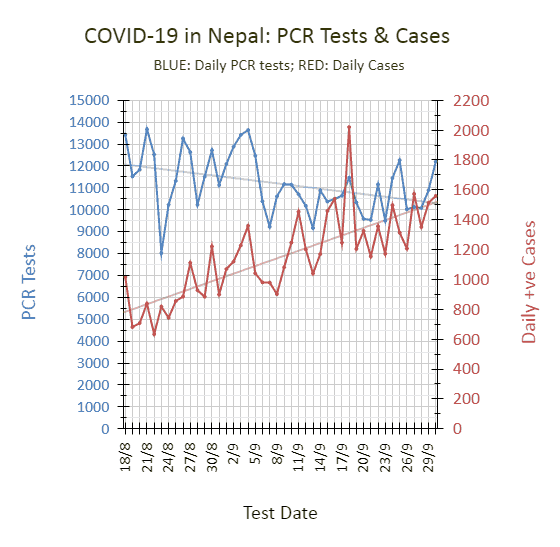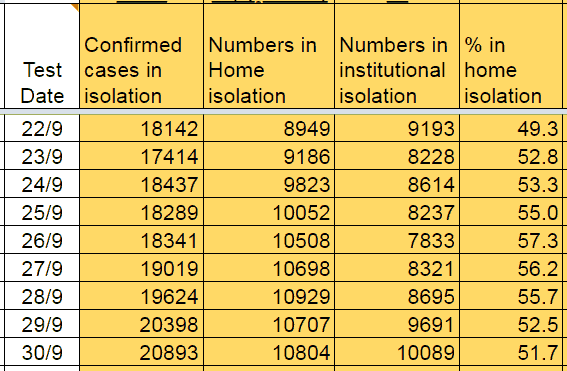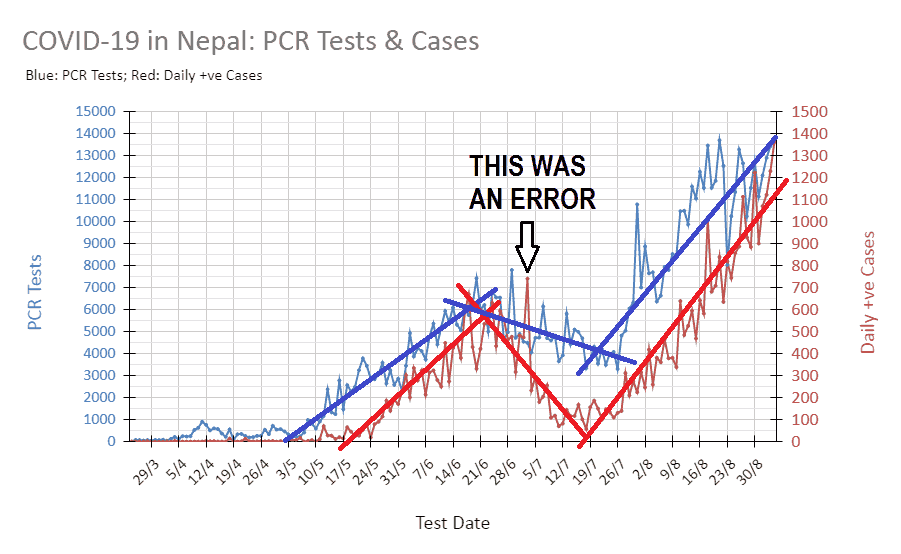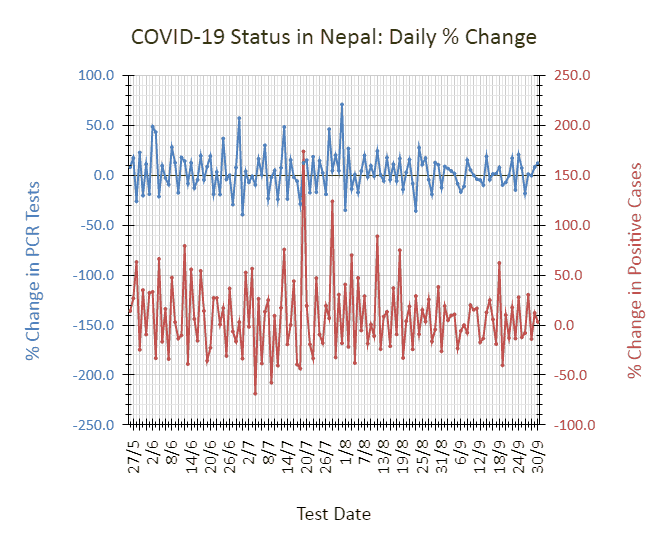On Sept 14, The Record reported that the Government of Nepal had planned to reducing PCR tests. The justification for it — as provided by the ministry’s joint spokesperson Dr Samir Kumar Adhikari — was, “Tests are not a cure.” So, those who don’t know what the tests are, will learn that it’s not a cure and therefore MIGHT NOT understand why reducing their numbers is the WRONG decision!
Rate of testing had been on the decline from towards the third week of August anyway (see chart below). The cases, however, has been trending up (red line).
Justifying the decrease in testing, Dr. Adhikari makes a TRUE statement which however does the opposite: “What is important in order to contain the virus is to quarantine and isolate the infected.”
Lowering the testing rate at a time when all evidence point to community and/or household level transmission, we will NOT be able to identify the necessary numbers of the infected — both symptomatic and asymptomatic — isolate sufficient number of the infected, and quarantine those who came in contact with them to contain and mitigate the spread of the virus. Far from it; decreasing testing does just the opposite!
He further says, “The asymptomatic do not need treatment in hospitals. They can stay at home for 14 days.” It is indeed true that the asymptomatic do NOT need hospitalization. However, those testing positive but asymptomatic should NOT be at home either. NOT at home in Nepal anyway, unless you belong to a househol with sufficient resources — such as spare rooms.
Regardless, the last several days, data show that the percent of active cases in home isolation has be around 50% (see table)!
The hardest hit demographics in the country, I am sure, is NO different from that in other countries: the lower class, the poor, and the uneducated. Forget the necessary resources — such as space — what percentage of such families in the country have the necessary know-how, cool headedness, and confidence to manage their COVID-positive family member properly without endangering other members of the family or even the neighborhood?
Besides, he makes it sound like over the course of 14 days at home the infected person basically is able to fight off the virus. Which is NOT necessarily true.
To begin with, studies have shown that asymptomatics do spread the virus. Furthermore, asymptomatic cases do have the potential to develop symptoms needing hospitalization. Knowing Nepal, there’s likely NO provision for a procedure or a contact person should the infection progress on that vein. Even if they do, I doubt the process will be anything but straight forward stressing the family members even more.
According to Setopati, the spokesperson also shared, “The ministry believes that only symptomatic persons should be tested and not testing asymptomatic ones does not make difference, but people should remain in quarantine.”
That of course, does NOT make any sense. To reiterate, if one is to mitigate the spread of the virus, one must have as accurate an assessment of the overall infection and the rate of spread of the virus within the population as possible. For that, there’s only ONE thing one can or must do: mass testing. In other words, test even those who show no symptoms and could potentially be asymptomatic!
Additional decisions the government has made, unfortunately, I am sure has contributed to the worsening of the pandemic: relaxing the prohibitions; allowing hotels and restaurants, retails stores to open; allowing vehicles to ply the streets etc. There’s been a continues increase in the positivity rate (red line in the chart below). So, naturally, tests conducted per confirmed case has been trending down (blue line).
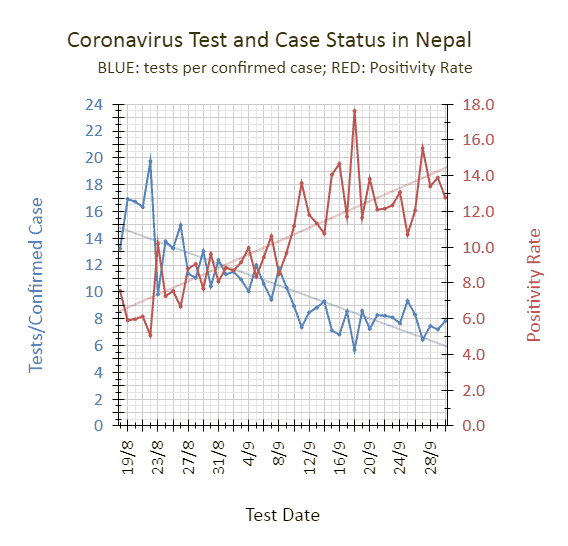 According to the WHO, positivity rate of 5% or below indicates that the country has brought the pandemic under countrol. 10 to 30 tests per confirmed case, again, according to the WHO, is a sign that sufficient tests are being conducted. The last time we satisfied that was about five weeks ago!
According to the WHO, positivity rate of 5% or below indicates that the country has brought the pandemic under countrol. 10 to 30 tests per confirmed case, again, according to the WHO, is a sign that sufficient tests are being conducted. The last time we satisfied that was about five weeks ago!
Another decision that undercuts the ability of the country to get anywhere near an accurate estimate for the level of infection, is the Ministry of Health and Population’s decision, on September 16, to stop testing the dead suspected of dying of COVID-19. This in spite of the fact that a significant percentage of COVID-19 deaths in the country were confirmed posthumously.
To a government keen to downplay the pandemic, that also has the added benefit of underestimating and keeping COVID deaths low.
The Record reports that all this could rather be an austerity measure. Alternatively, they have also reported that — at least according to some — the government may be laying the groundwork “to introduce rapid antigen tests, or rapid tests in the country” something “The National Health Research Centre has already finalised the policy and procedures” for.
Besides, to understand how scaling down testing might be the wrong decision, all one has to do is to look at how the pandemic has evolved over the last five months. Notice how the number of cases, deceptively, decreases with the decreasing number of tests from about the last week of June to the last day of lockdown 1.0, July 21 (the downward sloping red trend line in the chart below).
But that was likely a result of either the mode of testing or actual low number of incidence of infection rate or both. Afterall, the country had been under lockdown since March 24. The low rate of infections and the lack of community level spread was likely due to lack of penetration of different parts of the country by infected individual, most of whom were either arriving in the country by air in Kathmandu or from across the border in the Southern Plains.
The situation in the country has changed dramatically since then of course. A second wave began on July 28, a week after the end of lockdown 1.0. (See the upward sloping red trend line on the right hand side in the above chart.)
In the months that we have been facing this pandemic, the Government of Nepal has had NO strategy to tackle it. Notice how the daily changes to the daily PCR test numbers and cases (see image below) look like the heart-rate of one who has just completed a 100-m dash! They swing regularly and by a fair bit from one day to the next.
Forget about tackling everything else it has thrown at us — notably the loss of income during lockdown of daily wage workers and other poor citizens; the high rate of death by suicide; the disruptions to the economy. All of that was further complicated by the havoc the monsoon wreaked on the lives and livelihood of many. Has the Government done anything to cushion all that? No.
The only recent announcement of any note remotely related to a strategy has been their decision to call a lockdown if the number of active cases reach 25K. As of this day, the number stands at 20893. Over the last seven days, 350 active cases have been added to the total daily. If that holds, then 25K will be reached in about 11 days. But given the trend in cases, we’ll reach the number sooner than that.
I have come to conclude, once again, that the decision makers don’t value the lives of the citizens of this country. That had been the case way back in the aftermath of the 2015 mega-quakes. The country has been and continues to be led by morally bankrupt, incompetent, ignorant, and arrogant old men.
To top that, apparently, Russian Direct Investment Fund (RDIF) and some dodgy pharmaceutical company fronted by on person and called Trinity Pharmaceuticals has apparently agreed to supply 25 million doses of Sputnik V vaccine to the country. That’s just about 5 million shy of the total population of the country. Incidentally, not only is the Government NOT involved in acquisition of vaccines for its citizens, they were completely in the dark about this scheme!
While for the longest time we have been a country of parasites, we have the distinct potential for our country to turn into one of lab rats.
What do you think?
(If interested in other blog post about the status of COVID-19 in Nepal, click here, here, here, here, here, here, here, here, and here.)

